But Also Services
-
- Shipboard Pipe-joining Techniques Examined Maritime Reporter, Apr 2014 #98
Didier Vassal, Vice President OEM and Maritime Services at Victaulic, compares the flanged and grooved pipe-joining methodologies and explains the advantages that grooved pipe joints provide over flanges.
Efficient piping systems are essential for the range of services needed on board a vessel including secondary systems such as bilge and ballast systems, sea and fresh water cooling, lube oil, fire protection and deck wash.
For these systems, where piping class permits, an effective pipe-joining alternative to welding/flanging is the use of grooved mechanical joints which offer a range of technical, economic and practical benefits. These include enhanced performance; faster, simpler installation and maintenance and weight reduction on board.
Performance Issues
In a flanged pipe joint, two mating flanges are bolted together and compress a gasket to create a seal. As the bolts and nuts of a flanged joint absorb and compensate for system forces, over time the bolts and nuts can stretch and lose their original tightness due to pressure surges, system working pressure, vibration and thermal expansion and contraction. When these bolts experience torque relaxation, the gasket will lose its compressive seal, which can result in varying degrees of leakage.
Depending on the location and function of the piping system, leaks can be costly and hazardous, resulting in maintenance/repair downtime and exposure to risk. Gasket replacement will be required when the joint is taken apart, as the gasket will bond to the flange faces during the course of time. When the joint is disassembled, the gasket will need to be scraped from both flange faces and these surfaces will need to be cleaned before the gasket is replaced, again increasing maintenance downtime. Due to the bolting forces along with system expansion and contraction, flange gaskets can also develop compression “set” over time, presenting another cause of leakage.
The design of a grooved mechanical pipe joint overcomes these performance issues. A groove is first formed in the pipe end and the piping connection is secured by a coupling which houses a resilient, pressure-responsive elastomer gasket. The coupling housing fully encloses the gasket, reinforcing the seal and securing it in position as the coupling engages and forms a positive interlock into the pipe groove. The latest coupling technology enables pipes up to 24” (600mm) in diameter to be fully assembled with only two nuts and bolts in order to secure the self-restraining joint. The mechanical joint creates a triple seal due to the design relationship between the pipe, gasket and housings, which is enhanced when the system is pressurized.
Rigid and Flexible Couplings
Available in both rigid and flexible forms, grooved mechanical pipe couplings are Class Society Type Approved, and may be used in lieu of welded/flanged methods in 30 systems, subject to installation criteria established by each certifying agency.
Rigid couplings are used, for example, around areas such as manifolds and valves, where they offer easier access and replacement than flanges. By nature of their design, rigid couplings also provide axial and radial rigidity comparable to flanged or welded joints.
Flexible couplings have advantages in applications where relative movement between the pipe and supporting structure is anticipated, in addition to pipe movement resulting from thermal expansion or vibration. Expansion and contraction can stress the flange and piping, which can compromise the gasket over time. When this occurs, the joint is at risk of leaking. Grooved flexible couplings can accommodate pipe displacement in the form of axial movement or angular deflection. For this reason they are ideal for installing long piping runs especially between blocks where high seas can cause flanges to loosen over time, resulting in leaks and the risk of pipe separation. Both rigid and flexible couplings also provide the benefit of noise and vibration attenuation, eliminating the need for specialised noise reduction components and perishable rubber bellows or similar items.
Using a mechanical grooved piping system can speed up and simplify both installation and maintenance and improve the efficiency of onboard piping systems.
Ease of Installation
On initial installation, bolt holes of a flange must be precisely aligned and then tightened to hold the joint. The bolt-hole index on equipment inlets and outlets must also line up perfectly with the flange on the piping to be connected to the unit. With only one of a number of fixed positions determined by the number of holes in a flange, a fitting or valve can only be rotated to match the bolt holes. Additionally, the opposite end of the flanged pipe must also line up with its mating flange, which further increases assembly difficulty and the risk of misalignment.
Grooved piping systems do not have this problem and allow much more convenient installation with a full 360-degree rotation available for the pipe and mating components. There is no bolt-hole pattern to line up, and a coupling can be oriented at any position around the joint. The coupling can be rotated around the pipe to provide easy access to the bolts and simplify access to the equipment.
In addition to eliminating misalignment during installation, a coupling’s 360-degree orientation capabilities, together with its smaller profile compared to a flange, make the installation of grooved systems ideal for confined spaces.
Additionally, the installer can orient all of the assembly bolts on each joint in the same position to ease system inspection and maintenance.
Flanges are roughly twice the outside diameter of the pipe they are attached to. On average, grooved couplings are only half this size. The size advantage of the smaller design makes the grooved system ideal for jobs where space is limited, such as deck and wall penetrations - a fact recognised as far back as the 1930s when Victaulic couplings were originally used in U.K. shipyards.
Speed of Assembly
Because couplings have fewer bolts and no torque requirements up to 12” (300mm), grooved piping is much faster to install than flanging. Unlike flanges that must be welded to the pipe end, grooved valve assemblies do not require welding, which further cuts installation time and eliminates potential heat damage to the valve while also reducing safety risks by eliminating hot works.
A comparison of a DIN 150 ballast line installed using Victaulic grooved products versus traditional joining methods showed a 66% reduction in total installation time required (150.47 man hours vs. 443.16 man hours). The time needed to install 52 slip-on flanges and weld elbows and tees compared with 60 rigid couplings showed the largest time differences.
Couplings require just two bolts up to 24” (600mm) pipe size. For comparison, at the higher size range a flange would require a minimum of 20 sets of nuts and bolts.
In addition, flanges require time-consuming star pattern tightening with specialised wrenches to measure and ensure that correct torque specifications are achieved. Grooved pipe technology allows couplings to be assembled using standard hand tools and the joint is properly installed once the mating bolt pads of the coupling housings meet metal-to-metal. A simple visual inspection confirms correct assembly. Flanges, on the other hand, do not provide visual confirmation: the only measure to ensure proper assembly is to fill and pressurise the system, check for leaks and retighten the joints as needed.
Maintainability
The same characteristics of grooved piping systems that accelerate installation—fewer bolts and no torque requirements — also make system maintenance or alteration a quick and simple task. To gain access to a pump or valve, for example, the two bolts of the coupling are loosened, and the housings and gasket are removed from the joint. In a flanged system, multiple bolts need to be removed. The same time-consuming bolt-tightening sequence required upon initial installation is also required upon reassembly of the flange.
Because they do not require retightening, couplings eliminate much of the routine maintenance associated with flanges. Unlike a flange that puts variable stress on the gasket, nuts and bolts, a coupling holds the gasket in precise compression from the outside of the pipe joint. Additionally, since coupling gaskets are not subjected to high compressive forces, they do not need to be replaced on a regular maintenance schedule, while flange gaskets need to be replaced when the system is disassembled for maintenance.
To attenuate system noise and vibration, flanged systems require rubber bellows or braided flexible hoses. These items can fail due to overextension and, with normal wear, need to be replaced every 10 years on average, incurring cost and system downtime. Mechanical grooved pipe couplings, however, last the life of the system. Their ability to accommodate system vibration reduces the risk of joint failure, without the need for speciality products that require periodic repair or replacement. The resilient elastomeric gasket contained within both flexible and rigid couplings is very durable and can handle significant operating pressures and cyclical loading. A system can be pressurized and depressurized repeatedly without fatiguing the elastomer gasket.
Weight reduction
Valve assemblies are typically constructed with flanged components. However, this joining method can add unnecessary weight to a piping system. A 6” (150mm) flanged valve assembly constructed with a lug butterfly valve, connected with weld-neck flanges and eight bolts and nuts on each side of the valve, weighs approximately 85 lbs. A 6” (150mm) valve assembly that utilizes a grooved-end butterfly valve, grooved-end pipe and two rigid couplings to connect the components weighs approximately 35 lbs, representing a 58% weight reduction over the flanged assembly. A grooved valve assembly is therefore, an ideal alternative for the shipbuilding industry.
The above-mentioned comparison of a DIN 150 ballast line installed showed a weight reduction of 30 percent (2,164 lbs vs. 3,115 lbs) when Victaulic grooved products were used instead of traditional joining methods. The 52 slip-on flanges, bolt sets and gaskets, versus 60 rigid couplings accounted for major weight increases in the welded/flanged system.
Weight reductions by using grooved pipe couplings instead of flanges are achievable across a range of pipe sizes. The magnitude of the reduction depends on the pipe diameter and type of coupling used. In tests where piping was connected using one Victaulic Style 77 coupling – the heaviest coupling in the range – compared with two light-weight PN10 slip-on flanges the total installed weight of the grooved assemblies was significantly lower. Weight reductions were recorded as follows: 4” (100mm) – 67 percent; 12” (300mm) - 54 percent; 20” (500mm) – 60.5 percent.
With the lighter-weight flexible Style 75 or rigid Style 07 couplings and/or a heavier type of flange, weight reductions of 70% are easily achievable. As an example, a 24” (600mm) flanged set for a TG2 system would weigh 507 lbs but a comparable assembly using Victaulic couplings would weigh only 88 lbs. Shipyards that have used grooved couplings in preference to flanges on selected systems have recorded weight savings of 12 tons on offshore support vessels and 44 tons on cruise ships.
The economic benefits of grooved technology to ship owners are clear: less weight means more cargo or passengers and less fuel consumption. It makes the handling of piping systems on board easier as well.
Growing Trend
Grooved piping systems can offer significant advantages over their flanged equivalents because of their speed of installation, maintainability and reduced weight. These characteristics, coupled with additional benefits such as reliability, ease of alignment and lower safety risks, are leading owners, engineers and shipyards to choose grooved mechanical systems instead of flanges.
This growing trend towards the use of grooved technology is supported by suppliers of equipment such as heat exchangers, box coolers and chillers, along with valve and compressor manufacturers, many of whom are now providing their products with grooved end connections. The range of services where grooved pipe couplings may be used is steadily increasing. Building on successful applications in water systems, Victaulic is continuing its long history of innovation to develop fire-resistant gaskets and gain Type Approval for their use on maritime fuel services.
(As published in the April 2014 edition of Maritime Reporter & Engineering News - http://magazines.marinelink.com/Magazines/MaritimeReporter) -
- Cambla: Soft Solutions for Hard Problems Marine Technology, Apr 2016 #50
are applied Exportable error reports – This will allow the comprehensive error reports that are already produced to be exported for easier distribution, and to allow necessary modifications to be actioned quickly Revision of the screen layout – This revision will ensure more efficient use of
-
- Global Sulfur Cap: Maritime Must Prepare Now Maritime Reporter, Feb 2018 #48
implica¬tions at a time when the form of future environmental regulation is uncertain, and getting it wrong could signifi¬cantly disrupt operations. But decisions must be made: the IMO has recently reiterated that the 2020 deadline is firm. While it is not the role of shipping’s governing body to ensure
-
- DIRECTORY U.S. NAVY BUYING OFFICES Maritime Reporter, Nov 1984 #84
effect machine (GEM), or hydrofoil craft including construction, overhaul, modernization and conversion; propulsion; auxiliary power generating and distribution; navigational equipment; habitability and environment control features; shipmounted sonar, research, engineering, acquisition and support; shipmounted
-
- Trends in Marine Services for Subsea Telecoms Marine Technology, May 2021 #46
marine services (companies such as the Global Marine Group, SubCom, Alcatel Submarine Networks and Orange Marine) take different approaches to operations, but provide a mature and assured set of services that play a critical role in the industry. Marine services support the suppliers of undersea cable systems
-
- Hornbeck Offshore Services: Exerting Energy in All the Right Places Maritime Logistics Professional, Q2 2013 #24
the anticipated demand is at the core of CEO Todd Hornbeck’s short term business plan. That’s it. There are, of course, other key components of that vision, but it is the simplicity of the base premise that makes industry stakeholders sit up and take notice. Long term, the five year outlook is not much different
-
- ROV Services Market Update Marine Technology, May 2021 #14
Chart courtesy Kimberlite International Oilfield Research The ROV Services market continues to be a key component for helping subsea operators achieve greater levels of operational efficiency and to reduce costs and will play a growing role in supporting the expansion of future offshore wind projects with
-
- America's Sea Services Building Large Fleet of Small Ships and Craft Marine News, Jun 2023 #26
procured and managed by two Naval Sea Systems Command program offices—PMS 300 and PMS 325.Compared to warships and auxiliaries, the boats are small, but are made by a large number of boat builders across the country. For 2023, the most active contracts include: -40 Foot Patrol Boat (built by Metal
-
- Maritime Response Services & Non-Tank Vessel Response Plans Maritime Reporter, Sep 2018 #48
Avoiding Potential Pitfalls and HeadachesThe summer of Sub M may be over, but the heat remains for the tugboat and towing vessel industry operating under the July 20th regulations. Owner & Operators are faced with daily challenges to continually sustain and build their businesses. As with any new regulation
-
- Market in Focus: Offshore Services Vessels Maritime Reporter, Jun 2019 #38
Newbuild MarketUnsurprisingly, across the offshore sectors, newbuild orders have been scarce to none. Oversupply is still a major problem for the industry and due to slippage, ordering vessels now would be counterproductive. Why order brand new vessels from a yard and wait several years for these to be
-
- MTR100: QPS-US (Quality Positioning Services) Marine Technology, Aug 2015 #27
104 Congress St, Ste 304 Portsmouth, NH 03801 T: +1-603-431-1773 E: [email protected] W: http://www.qps-us.com CEO: Tomas Hjelmberg No. of Employees: 50 QPS are specialists in software solutions for marine spatial data. Software products for efficient data collection
-
- Avalon Freight Services Redefines the Shortsea Shipping Formula Marine News, Sep 2016 #36
Anything but business as usual, trusted partners operate innovative, environmentally correct and cutting edge equipment – in a decidedly niche trade. A new freight service began operation in southern California this past April. For the businesses and residents of Catalina Island who depend on
-
 )
March 2024 - Marine Technology Reporter page: 48
)
March 2024 - Marine Technology Reporter page: 48Index page MTR MarApr2024:MTR Layouts 4/4/2024 3:19 PM Page 1 Advertiser Index PageCompany Website Phone# 17 . . . . .Airmar Technology Corporation . . . . . . . . . .www.airmar.com . . . . . . . . . . . . . . . . . . . . . . . . . . . . . . . . .(603) 673-9570 9 . . . . . .Birns, Inc. . . . . . . . . . .
-
 )
March 2024 - Marine Technology Reporter page: 45
)
March 2024 - Marine Technology Reporter page: 45ronments. The new agreement will address speci? c techni- cal gaps in the UUV defense and offshore energy markets especially for long duration, multi-payload mission opera- tions where communications are often denied or restricted. As part of the new alliance, Metron’s Resilient Mission Autonomy portfolio
-
 )
March 2024 - Marine Technology Reporter page: 9
)
March 2024 - Marine Technology Reporter page: 9, and bottom mines. Detecting be neutralized by EOD divers through controlled detonation, drifting contact mines will be particularly challenging, as this but unmanned systems are a safer and equally effective op- will require visual detection from commercial, military, or rec- tion. The SeaFox from Atlas
-
 )
March 2024 - Marine Technology Reporter page: 6
)
March 2024 - Marine Technology Reporter page: 6the hadal depths to routine exploration. He writes Scripps Institution of Oceanography. for the Journal of Diving History and the MTR. Authors & Contributors Konowe Quinn Konowe Celia Konowe is from Reston, Va., and has a bachelor’s degree in environmental studies. She has study abroad experience in
-
 )
March 2024 - Marine Technology Reporter page: 4
)
March 2024 - Marine Technology Reporter page: 4the world opening up post- Gregory R. Trauthwein [email protected] COVID – was a mere shell of its former self. MTR participated in the 2022 event, but I skipped it as we went back out into the world with a minimalist approach in terms of the Contributing Writers Kevin Hardy number of team members
-
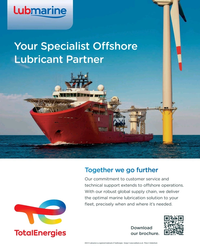 )
April 2024 - Maritime Reporter and Engineering News page: 3rd Cover
)
April 2024 - Maritime Reporter and Engineering News page: 3rd CoverYour Specialist Ofshore Lubricant Partner T Togeth her w we go o furt ther r Our commitment to customer service and technical support extends to ofshore operations. With our robust global supply chain, we deliver the optimal marine lubrication solution to your ?eet, precisely when and where it’s needed.
-
 )
April 2024 - Maritime Reporter and Engineering News page: 48
)
April 2024 - Maritime Reporter and Engineering News page: 48Index page MR Apr2024:MN INDEX PAGE 4/5/2024 1:33 PM Page 1 ANCHORS & CHAINS MILITARY SONAR SYSTEMS tel:+44 (0) 1752 723330, [email protected] , www.siliconsensing.com Anchor Marine & Supply, INC., 6545 Lindbergh Houston, Massa Products Corporation, 280 Lincoln Street, SONAR TRANSDUCERS
-
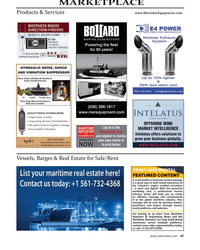 )
April 2024 - Maritime Reporter and Engineering News page: 47
)
April 2024 - Maritime Reporter and Engineering News page: 47MARKETPLACE Products & Services www.MaritimeEquipment.com Powering the fleet for 60 years! HYDRAULIC NOISE, SHOCK AND VIBRATION SUPPRESSOR Noise, Shock, VibraO on & PulsaO on in Quiet, Smooth Flow Out Oil Bladder Nitrogen (blue) Manufactured by MER
-
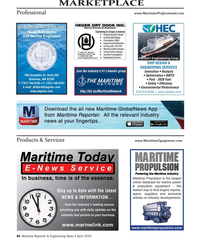 )
April 2024 - Maritime Reporter and Engineering News page: 46
)
April 2024 - Maritime Reporter and Engineering News page: 46MARKETPLACE Professional www.MaritimeProfessional.com GILBERT ASSOCIATES, INC.GILBERT ASSOCIATES, INC. Naval Architects and Marine Engineers SHIP DESIGN & ENGINEERING SERVICES Join the industry’s #1 Linkedin group )NNOVATION
-
 )
April 2024 - Maritime Reporter and Engineering News page: 43
)
April 2024 - Maritime Reporter and Engineering News page: 43testing of ships, “I don't say that crews must be soft- tive fuels, carbon capture, batteries and and a regulatory framework which takes ware engineers, but there is no going fuel cell power will all provide critical account of the ‘graceful deterioration’ of back: there has to be both a systematic pathways
-
 )
April 2024 - Maritime Reporter and Engineering News page: 38
)
April 2024 - Maritime Reporter and Engineering News page: 38Tech Files Latest Products, Systems and Ship Designs Zero-Emission Mooring Service of a Tanker Consulmar achieved a milestone by executing what it calls ing boat Castalia, which operates on full electric propulsion. the world's ? rst zero-emissions mooring service for a tanker. Equipped with two 150 kW
-
 )
April 2024 - Maritime Reporter and Engineering News page: 28
)
April 2024 - Maritime Reporter and Engineering News page: 28and roll on/roll off ships, two expeditionary transfer docks (ESDs) and four expeditionary sea base ships. We also have two offshore petro- leum distribution system ships that help move fuel ashore. Another ten preposition ships support the Army and Air Force. It should be pointed out that we can build
-
 )
April 2024 - Maritime Reporter and Engineering News page: 27
)
April 2024 - Maritime Reporter and Engineering News page: 27in other ways. That had an impact on our Admiral program to grow young Sailors into future leaders. workforce. We thought we would have rebounded by now, but Likewise, we have a similar program we call “Hawsepipe.” many of our mariners have not come back. We have people who started on the deckplates who
-
 )
April 2024 - Maritime Reporter and Engineering News page: 25
)
April 2024 - Maritime Reporter and Engineering News page: 25sustain our forces ers, towing, salvage and rescue tugs, and expeditionary fast transports and emergency medical ships. A large percent- engaged in distributed maritime operations (DMO). MSC currently has 140 ships globally, including ships age of our ships are 40 years old or older and need to be that
-
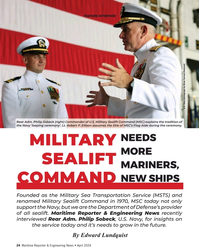 )
April 2024 - Maritime Reporter and Engineering News page: 24
)
April 2024 - Maritime Reporter and Engineering News page: 24Founded as the Military Sea Transportation Service (MSTS) and renamed Military Sealift Command in 1970, MSC today not only support the Navy, but we are the Department of Defense’s provider of all sealift. Maritime Reporter & Engineering News recently interviewed Rear Adm. Philip Sobeck, U.S
-
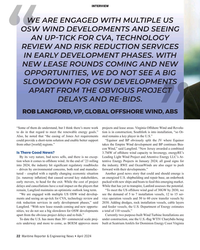 )
April 2024 - Maritime Reporter and Engineering News page: 22
)
April 2024 - Maritime Reporter and Engineering News page: 22SLOWDOWN FOR OSW DEVELOPMENTS APART FROM THE OBVIOUS PROJECT DELAYS AND RE-BIDS. ROB LANGFORD, VP, GLOBAL OFFSHORE WIND, ABS “Some of them do understand, but I think there’s more work projects and lease areas. Virginia Offshore Wind and Revolu- to do in that regard to meet the renewable energy goals.” tion
-
 )
April 2024 - Maritime Reporter and Engineering News page: 21
)
April 2024 - Maritime Reporter and Engineering News page: 21ROB LANGFORD, VP, GLOBAL OFFSHORE WIND ob Langford has worked in the offshore industry ABS. “We are growing and evolving our services across all for more than three decades, ‘cutting his teeth’ offshore infrastructure along with our continued support to the in a UK design ? rm working in the North Sea
-
 )
April 2024 - Maritime Reporter and Engineering News page: 16
)
April 2024 - Maritime Reporter and Engineering News page: 16MARKETS SOVs – Analyzing Current, Future Demand Drivers By Philip Lewis, Director of Research, Intelatus © Björn Wylezich/AdobeStock t a high-level, there are three solutions to transferring Lower day rate CTVs are often used for daily transfer of technicians from shore bases to offshore wind farms
-
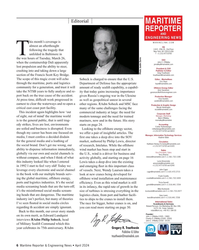 )
April 2024 - Maritime Reporter and Engineering News page: 6
)
April 2024 - Maritime Reporter and Engineering News page: 6that are dangerous. The maritime logistics chain, from port and harbor facili- Gary Lewis [email protected] | +1.516.441.7258 industry isn’t perfect, but many of theories ties to ships to the cranes to install them. International Sales I’ve seen ? oated in social media circles The race for bigger
-
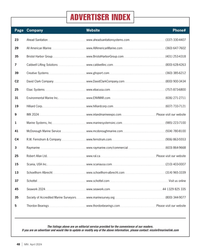 )
April 2024 - Marine News page: 48
)
April 2024 - Marine News page: 48ADVERTISER INDEX Page Company Website Phone# 23 Ahead Sanitation www.aheadsanitationsystems.com (337) 330-4407 29 All American Marine www.AllAmericanMarine.com (360) 647-7602 35 Bristol Harbor Group www.BristolHarborGroup.com (401) 253-4318 7 Caldwell Lifting Solutions www.caldwellinc.com (800)
-
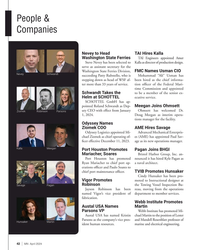 )
April 2024 - Marine News page: 42
)
April 2024 - Marine News page: 42People & Companies Nevey to Head TAI Hires Kalla Washington State Ferries TAI Engineers appointed Amer Steve Nevey has been selected to Kalla as director of production design. serve as assistant secretary for the FMC Names Usman CIO Washington State Ferries Division, Nevey Schwandt succeeding Patty
-
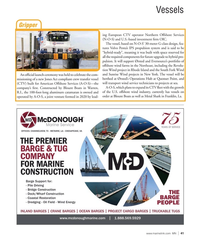 )
April 2024 - Marine News page: 41
)
April 2024 - Marine News page: 41Vessels Gripper ing European CTV operator Northern Offshore Services (N-O-S) and U.S.-based investment ? rm OIC. The vessel, based on N-O-S’ 30-meter G-class design, fea- tures Volvo Penta’s IPS propulsion system and is said to be “hybrid-ready”, meaning it was built with space reserved for all the
-
 )
April 2024 - Marine News page: 35
)
April 2024 - Marine News page: 35Capt. Josh Ferguson, master of the eWolf. Administration (MARAD), which all provided ? nancial support and other resources. “This tug becomes somewhat commercially viable be- cause of the grant process,” Manzi said. “Unlike a ferry service that’s paid for by tax dollars, we have to collect fares and
-
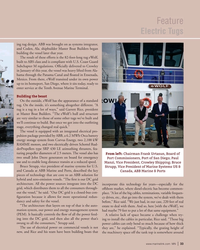 )
April 2024 - Marine News page: 33
)
April 2024 - Marine News page: 33, president at Master Boat Builders. “The eWolf’s hull and structure are very similar to those of some other tugs we’ve built and we’ll continue to build. But once we got into the out? tting stage, everything changed real quick.” The vessel is equipped with an integrated electrical pro- pulsion package provided
